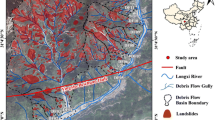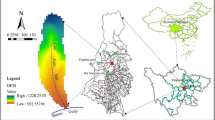Abstract
At 14:00 on 18 June 2017, floods occurred in Shiyang gully at the junction of Beijing and Hebei Province, China. The floods put 12 people at risk, 6 of whom died. After the occurrence of the floods, the environment in Shiyang gully has undergone tremendous changes. There are many loose residual materials in the watershed. Therefore, it was necessary to evaluate the debris flow susceptibility of Shiyang gully after the disaster. The factor analysis method, entropy weighting method and geomorphic information entropy method were used to evaluate the debris flow susceptibility of each sub-watershed in Shiyang gully. By comparison with the technical standard published by the China Ministry of Lands and Resources, it was found that the susceptibility assessment results are not ideal. To improve the accuracy of the assessment results, we used a comprehensive method. The accuracy of the susceptibility assessment obtained by the comprehensive method is 87.5%. This accuracy shows that the comprehensive method is applicable to the susceptibility assessment of debris flows in this region. To predict the runout path of potential debris flows in four sub-watersheds with very high susceptibility, the authors used the SFLOW software developed by Jilin University to simulate the debris flow hazards. Combined with the on-site investigation data, debris flows in the four sub-watersheds were simulated at 10-, 20-, 50-, and 100-year recurrence intervals. The obtained runout path could provide some guidance and reference for the avoidance of disasters and treatment of debris flows.
Article Highlights
-
Introduces the flood that occurred in Shiyang gully, the junction of Beijing and Hebei Province, China.
-
A comprehensive method was used to evaluate the susceptibility of each sub-watershed in Shiyang gully.
-
The runout path of potential debris flow in four very high susceptibility sub-watersheds was predicted.














Similar content being viewed by others
References
Abancó C, Hürlimann M (2014) Estimate of the debris-flow entrainment using field and topographical data. Nat Hazards 71:363–383. https://doi.org/10.1007/s11069-013-0930-5
Ai NS, Yue TX (1988) Second discussion of the comentropy of drainage system. Soil Water Conserv 2:1–7 (in Chinese)
Bao Y, Sun X, Chen J, Zhang W, Han X, Zhan J (2019a) Stability assessment and dynamic analysis of a large iron mine waste dump in Panzhihua, Sichuan, China. Environ Earth Sci 78:48. https://doi.org/10.1007/s12665-019-8043-4
Bao Y et al (2019b) Debris flow prediction and prevention in reservoir area based on finite volume type shallow-water model: a case study of pumped-storage hydroelectric power station site in Yi County, Hebei, China. Environ Earth Sci 78:577. https://doi.org/10.1007/s12665-019-8586-4
Cao C, Xu P, Chen J, Zheng L, Niu C (2017) Hazard assessment of Debris-flow along the Baicha River in Heshigten Banner, Inner Mongolia, China. Int J Environ Res Public Health 14:30. https://doi.org/10.3390/ijerph14010030
Chen CC, Tseng CY, Dong JJ (2007) New entropy-based method for variables selection and its application to the debris-flow hazard assessment. Eng Geol 94:19–26. https://doi.org/10.1016/j.enggeo.2007.06.004
Chen HX, Zhang LM, Zhang S, Xiang B, Wang X (2013) Hybrid simulation of the initiation and runout characteristics of a catastrophic debris flow. J Mt Sci 10:219–232. https://doi.org/10.1007/s11629-013-2505-z
Chen HX, Zhang LM, Gao L, Yuan Q, Lu T, Xiang B, Zhuang WH (2017a) Simulation of interactions among multiple debris flows. Landslides 14:595–615. https://doi.org/10.1007/s10346-016-0710-x
Chen J, Li Y, Zhou W, Iqbal J, Cui Z (2017b) Debris-flow susceptibility assessment model and its application in semiarid mountainous areas of the Southeastern Tibetan Plateau. Nat Hazards Rev 18:15. https://doi.org/10.1061/(asce)nh.1527-6996.0000229
Chen JJ et al (2018) Debris flow susceptibility mapping using an improved information value model based on a combination weighting method for Jilin Province, China. Fresenius Environ Bull 27:9706–9716
Conoscenti C, Ciaccio M, Caraballo-Arias NA, Rotigliano E, Agnesi V (2015) Assessment of susceptibility to earth-flow landslide using logistic regression and multivariate adaptive regression splines: a case of the Belice River basin (western Sicily, Italy). Geomorphology 242:49–64. https://doi.org/10.1016/j.geomorph.2014.09.020
Dai Z, Huang Y, Cheng H, Xu Q (2017) SPH model for fluid–structure interaction and its application to debris flow impact estimation. Landslides 14:917–928. https://doi.org/10.1007/s10346-016-0777-4
Devkota KC et al (2013) Landslide susceptibility mapping using certainty factor, index of entropy and logistic regression models in GIS and their comparison at Mugling-Narayanghat road section in Nepal Himalaya. Nat Hazards 65:135–165. https://doi.org/10.1007/s11069-012-0347-6
Di BF et al (2019) Assessing susceptibility of debris flow in Southwest China using gradient boosting machine. Sci Rep 9:12532. https://doi.org/10.1038/s41598-019-48986-5
Elkadiri R et al (2014) A remote sensing-based approach for debris-flow susceptibility assessment using artificial neural networks and logistic regression modeling. IEEE J Sel Top Appl Earth Observ Remote Sens 7:4818–4835. https://doi.org/10.1109/jstars.2014.2337273
Fannin RJ, Wise MP (2001) An empirical-statistical model for debris flow travel distance. Can Geotech J 38:982–994. https://doi.org/10.1139/t01-030
Golovko D, Roessner S, Behling R, Wetzel HU, Kleinschmit B (2017) Evaluation of remote-sensing-based landslide inventories for hazard assessment in Southern Kyrgyzstan. Remote Sens 9:943. https://doi.org/10.3390/rs9090943
Gómez H, Kavzoglu T (2005) Assessment of shallow landslide susceptibility using artificial neural networks in Jabonosa River Basin, Venezuela. Eng Geol 78:11–27. https://doi.org/10.1016/j.enggeo.2004.10.004
Gregoretti C, Degetto M, Boreggio M (2016) GIS-based cell model for simulating debris flow runout on a fan. J Hydrol 534:326–340. https://doi.org/10.1016/j.jhydrol.2015.12.054
Guan F et al (2019) Evaluation of the competitiveness of China’s commercial banks based on the G-CAMELS evaluation system. Sustainability 11:1791. https://doi.org/10.3390/su11061791
Han X, Chen J, Xu P, Zhan J (2017) A well-balanced numerical scheme for debris flow run-out prediction in Xiaojia Gully considering different hydrological designs. Landslides 14:1–10. https://doi.org/10.1007/s10346-017-0850-7
Han Z et al (2019) Numerical simulation of debris-flow behavior based on the SPH method incorporating the Herschel–Bulkley–Papanastasiou rheology model. Eng Geol 255:26–36. https://doi.org/10.1016/j.enggeo.2019.04.013
Hungr O (1995) A model for the runout analysis of rapid flow slides, debris flows, and avalanches. Can Geotech J 32:610–623
Hungr O, Fell R, Couture R, Eberhardt E (2005) Landslide risk management. In: Proceedings of the international conference on landslide risk management, Vancouver, Canada, 31 May-3 June 2005. Taylor and Francis, London, p 776
Kaiser HF (1958) The varimax criterion for analytic rotation in factor analysis. Psychometrika 23:187–200. https://doi.org/10.1007/BF02289233
Kazakova E, Lobkina V, Gensiorovskiy Y, Zhiruev S (2017) Large-scale assessment of avalanche and debris flow hazards in the Sakhalin region, Russian Federation. Nat Hazards 88:237–251. https://doi.org/10.1007/s11069-016-2431-9
Krumbein WC (1977) Geological factor analysis. Earth Sci Rev 13:107–108. https://doi.org/10.1016/0012-8252(77)90104-0
Li X, Yang W, Luo Z, Li H, Ao T (2010) Site Selection for the immigrants of post-earthquake region of Wenchuan County based on RS and GIS technology. J Sichuan Univ (Eng Sci Ed) 42:83–91
Lin ML, Wang KL, Huang JJ (2005) Debris flow run off simulation and verification - case study of Chen-You-Lan Watershed, Taiwan. Nat Hazards Earth Syst Sci 5:439–445. https://doi.org/10.5194/nhess-5-439-2005
Liu X, Miao C (2018) Large-scale assessment of landslide hazard, vulnerability and risk in China. Geomat Nat Hazards Risk 9:1037–1052. https://doi.org/10.1080/19475705.2018.1502690
Liu H, Tang C (2007) Development of digital disaster reduction system for debris flow in urban district of Dongchuan. J Nat Disasters 16:7–11. https://doi.org/10.3969/j.issn.1004-4574.2007.03.002
Liu L, Wang S (1995) Fuzzy comprehensive evaluation on landslide and debris flow risk degree in Zaotong, Yunnan. Mt Res 13:261–266 (In Chinese)
Liu Y, Hu H, Bai Z (2001) Artificial neural network method for evaluating the dangerous degree of debris flows. Geol Prospect 28:84–87 (in Chinese)
Lowe DA, Nguyen CM, Copeland CT, Linck F (2020) Factor analysis of the Texas functional living scale in an outpatient clinical sample. Arch Clin Neuropsychol 35:116–121. https://doi.org/10.1093/arclin/acz005
Ni S, Ma C, Yang H, Zhang Y (2018) Spatial distribution and susceptibility analysis of avalanche, landslide and debris flow in Beijing mountain region. J Beijing For Univ 40:81–91. https://doi.org/10.13332/j.1000-1522.20170328
Niu C (2013) Index selection and rating for debris flow hazard assessment. Dissertation of Doctoral Degree. Jilin University, Changchun
O’Brien JS (2006) FLO-2D User’S manual version 200601, FLO-2D Software, Inc, Nutrioso
O’Brien JS, Julien PY (1988) Laboratory analysis of mudflow properties. J Hydraul Eng 114:877–887
Rickenmann D (1999) Empirical relationships for debris flows. Nat Hazards 19:47–77. https://doi.org/10.1023/A:1008064220727
Scally FAD, Owens IF, Louis J (2010) Controls on fan depositional processes in the schist ranges of the Southern Alps, New Zealand, and implications for debris-flow hazard assessment. Geomorphology 122:99–116. https://doi.org/10.1016/j.geomorph.2010.06.002
Spearman C (1904) General intelligence, objectively determined and measured. Am J Psychol 15:201–292. https://doi.org/10.2307/1412107
Stamatopoulos C, Di B (2015) Analytical and approximate expressions predicting post-failure landslide displacement using the multi-block model and energy methods. Landslides 12:1207–1213. https://doi.org/10.1007/s10346-015-0638-6
Takahashi T (2014) Debris flow: mechanics, prediction, and countermeasures, 2nd edn. CRC Press, London
Tan B (1986) Quantified comprehensive evaluation for the scope and inrensity of mud-rock flow gully activity. J China Railw Soc 8:74–82 (in Chinese)
Wang J, Yu Y, Yang S, Lu G-H, Ou G (2014) A modified certainty coefficient method(M-CF) for Debris flow susceptibility assessment: a case study for the Wenchuan earthquake meizoseismal areas. J Mt Sci 11:1286–1297. https://doi.org/10.1007/s11629-013-2781-7
Wang Z, Wang C, Wang Z (2018) The hazard analysis of water inrush of mining of thick coal seam under reservoir based on entropy weight evaluation method. Geotech Geol Eng 36:3019–3028. https://doi.org/10.1007/s10706-018-0520-0
Wu S, Chen J, Zhou W, Iqbal J, Yao L (2019) A modified logit model for assessment and validation of debris-flow susceptibility. Bull Eng Geol Environ 78:4421–4438. https://doi.org/10.1007/s10064-018-1412-5
Wu S et al (2020) Susceptibility assessments and validations of debris-flow events in meizoseismal areas: case study in China’s Longxi River watershed. Nat Hazards Rev 21:0501900. https://doi.org/10.1061/(ASCE)NH.1527-6996.0000347
Xie T et al (2019) Risk assessment of glacial debris flow along the Tianshan Highway based on geomorphic information entropy. J Glaciol Geocryol 41:400–406 (in Chinese)
Xu W, Yu W, Jing S, Zhang G, Huang J (2013) Debris flow susceptibility assessment by GIS and information value model in a large-scale region, Sichuan Province (China). Nat Hazards 65:1379–1392. https://doi.org/10.1007/s11069-012-0414-z
Zhang W, Chen J, Wang Q, Qian X, Xiang L (2013) Susceptibility analysis of large-scale debris flows based on combination; weighting and extension methods. Nat Hazards 66:1073–1100. https://doi.org/10.1007/s11069-012-0539-0
Zhang Y, Ge T, Tian W, Liou Y (2019) Debris flow susceptibility mapping using machine-learning techniques in Shigatse area, China. Remote Sens 11:2801. https://doi.org/10.3390/rs11232801
Acknowledgements
This work was supported by the National Natural Science of China (Grant No. U1702241 and 41702301) and Opening fund of State Key Laboratory of Geohazard Prevention and Geoenvironment Protection (Chengdu University of Technology) (Grant No. SKLGP2018K017).
Author information
Authors and Affiliations
Corresponding author
Ethics declarations
Conflict of interest
On behalf of all authors, the corresponding author states that there is no conflict of interest.
Electronic supplementary material
Below is the link to the electronic supplementary material.
Rights and permissions
About this article
Cite this article
Li, Y., Chen, J., Zhang, Y. et al. Debris Flow Susceptibility Assessment and Runout Prediction: A Case Study in Shiyang Gully, Beijing, China. Int J Environ Res 14, 365–383 (2020). https://doi.org/10.1007/s41742-020-00263-4
Received:
Revised:
Accepted:
Published:
Issue Date:
DOI: https://doi.org/10.1007/s41742-020-00263-4




